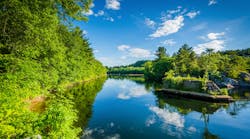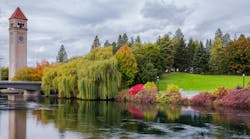BY DAWN KRISTOF CHAMPNEY
Twenty-one speakers from Capitol Hill, the administration, states, utilities, and the private industry offered unique perspectives on a variety of topics impacting the water and wastewater sector, from funding and regulations to fracking and export trade. With so much material covered in the jam-packed two-day session, it is challenging to capture all of the highlights, but here are some worth noting:
1. Chaos on Capitol Hill is the New Norm. Congressman Bill Pascrell spoke passionately about the challenges of passing bipartisan legislation that would provide an alternative source of funding to meet the nation's enormous water and wastewater infrastructure needs. He applauded the administration in calling for elimination of the volume cap on private activity bonds for water infrastructure as part of the fiscal 2014 budget. He noted that his legislative proposal could provide up to $50 billion over 10 years in private investment funds for water-related infrastructure at a cost of only $258 million in lost tax revenue to the U.S. Treasury.
2. Demand for technology innovation is the New Norm. Jeff Lape, deputy director of the Office of Science and Technology in EPA's Office of Water, presented EPA's top 10 technology needs for water, among them being nutrient reduction and recovery; energy reduction and recovery at treatment plants; water reuse and monitoring; increased resiliency of water infrastructure; and improved reliability of small systems.
3. Dwindling federal investment in infrastructure is the New Norm. According to Peter Shanaghan, team leader of the EPA Drinking Water State Revolving Fund, drinking water will be competing with other infrastructure and other discretionary spending for a slice of a diminishing federal funding pie; as a result, greater emphasis will be placed on helping communities access the limited funds remaining.
4. Energy independence could become the New Norm with new production technologies providing greater access to natural gas. Former EPA Acting Administrator Marianne Horinko, president of The Horinko Group, reported that the Energy Information Administration has estimated that U.S. natural gas reserve volumes are equivalent to a 93-year supply at current consumption rates. She cautioned, however, that innovative methods for minimizing its impact on water resources and reusing wastewater generated will be needed to make energy independence a reality.
5. Water efficiency is the New Norm for the U.S. Department of Defense. David Asiello, program manager in the Office of the Deputy Under Secretary, Installations & Environment, said that with the DOD having consumed 90 billion gallons of water in fiscal 2012 as well as a directive to reduce consumption 26 percent by fiscal 2020 (baseline 2007), reducing water usage has become "mission imperative."
6. Technology is replacing "boots on the ground" as part of the New Norm in regulatory enforcement. David Hindin, who leads EPA's Next Generation Compliance initiative, spoke about staffing reductions and the need to place greater emphasis on technologies that "make the invisible visible," detect pollution in real time and expand transparency. Alexandra Dunn, executive director of the Association of Clean Water Administrators, presented the results from a recent survey identifying how advances in monitoring and information technology are being applied by states to improve compliance and enforcement results.
7. Expanded market access is the New Norm in the White House Office of the U.S. Trade Representative. According to Jennifer Prescott, assistant U.S. Trade Representative for Environmental and Natural Resources, USTR is in the process of negotiating two of the most significant U.S. bilateral free trade agreements with Europe and Asia-Pacific nations. These agreements would provide unprecedented scope of access to government procurement markets for U.S. water and wastewater equipment manufacturers, she indicated.
8. Slow growth in public spending is (unfortunately) the New Norm for water and sewage projects. Ken Simonson, chief economist at the Associated General Contractors of America, reported that overall water and sewage markets are still in decline, attributed in part to the continued decline in federal support of the state revolving fund programs, a pattern which is expected to continue through 2014.
9. Value-based procurement is becoming the New Norm as utilities learn to do more with less. Nigel Grace, who leads Brown and Caldwell's drinking water growth initiative, said that this is especially true for complex pieces of equipment that have an energy component. Don Howard, water reclamation manager for the City of Greensboro (NC), concurred. His director tells him: "You make your own fate; you live with it, so buy with value in mind."
10. Stricter nutrient levels are the New Norm to achieve state water quality standards. Sheila Frace, deputy director of EPA's Office of Wastewater Management, said it remains to be seen whether the stricter levels are achievable or affordable. They will prove especially challenging for the 700 small systems struggling to manage nutrients in the Susquehanna River basin, said Ed Gillette of EEMA.
One final takeaway worth noting (though not necessarily related to any New Norm) was a sentiment expressed by several of the speakers on this year's Washington Forum program, that being the need for integrity, honesty and open communication among all participants in the industry. Chretien Voerg, superintendent of the Town of Colonie (NY) Department of Public Works, put it quite succinctly by calling upon the manufacturers and representatives in the audience to "tell us why you are the best and not why your competitors are the worst." That's good advice under any norm.
About the Author:Dawn Kristof Champney is president of the Water and Wastewater Equipment Manufacturers Association, a 105-year old national trade organization representing the interests of companies that manufacture and supply products for use in potable water and wastewater treatment applications.
More WaterWorld Current Issue Articles
More WaterWorld Archives Issue Articles


